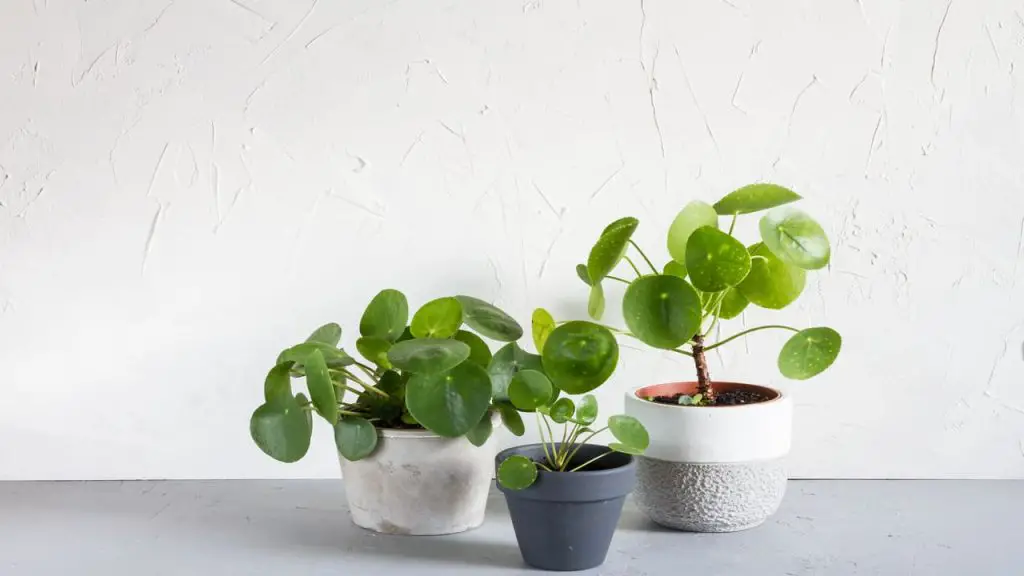As an Amazon Associate, I earn from qualifying purchases.
The Chinese money plant or Pilea Peperomioides is a beautiful indoor plant that’s simple to take care of. Its round leaves look very elegant and it’s originally from China. People all over the world love it because it doesn’t need a lot of attention.
If you’ve been taking care of plants for a while or you’re just starting your collection, you should get a Chinese money plant. It’s a great way to add some greenery and beauty to any room!
In this article, we will explore the best practices for taking care of Chinese money plants, including soil and lighting requirements, watering and fertilization tips, and pest control measures.
So, let’s get started with this care guide to help you keep your Chinese money plant healthy and thriving.
1. How To Take Care Of Chinese Money Plant: Tips for Success

1.1 Light Requirements
Chinese money plants need a good amount of light to grow well, but not direct sunlight. Too much direct sunlight can make the leaves burn and turn brown. However, if they don’t get enough light, the leaves can become yellow and fall off.
To give your plant the right amount of light, put it near a window with plenty of light, but not direct sunlight. You can also place it in a well-lit room or use a grow light.
The key is to find the right balance of light. If you do this, your Chinese money plant will grow well and look healthy and beautiful.
1.2 Watering and Humidity
Chinese money plants prefer consistently moist soil, but they are susceptible to root rot if overwatered. Overwatering can cause the soil to become waterlogged, which can lead to the roots becoming saturated and eventually rotting.
To avoid this, it’s important to water your Chinese money plant only when the top inch of soil feels dry to the touch. You can test the soil moisture level by sticking your finger about an inch into the soil. If it feels dry, it’s time to water your plant.
When watering your Chinese money plant, make sure the pot has adequate drainage to allow excess water to drain away. Avoid letting the plant sit in standing water, as this can cause the soil to become too wet and lead to root rot.
Chinese money plants also prefer moderate humidity levels, which can be a challenge in dry indoor environments. You can increase the humidity around your plant by using a humidifier, placing a tray of water near the plant, or misting the leaves with water.
However, be careful not to over-mist the plant, as this can also cause excess moisture and lead to fungal growth. The key to watering and humidity for Chinese money plants is to provide consistent moisture without overwatering or allowing the soil to become waterlogged.
1.3 Soil and Fertilization
Chinese money plants prefer well-draining soil that is rich in organic matter. The soil should allow excess water to drain away easily, as Chinese money plants are susceptible to root rot if the soil becomes waterlogged.
To create a suitable growing medium for your plant, you can mix equal parts potting soil, perlite, and peat moss. This will provide good drainage and enough organic matter for the plant to thrive.
In terms of fertilization, it’s best to fertilize your Chinese money plant once a month during the growing season, which is typically spring and summer. You can use a balanced fertilizer with equal parts nitrogen, phosphorus, and potassium. This will provide your plant with the nutrients it needs to grow and remain healthy.
When fertilizing your Chinese money plant, it’s important not to over-fertilize, as this can lead to fertilizer burn and damage to the roots. Follow the instructions on the fertilizer package and apply the fertilizer in moderation. You can also use a diluted fertilizer solution to reduce the risk of over-fertilizing.
The crucial aspect of maintaining healthy soil and fertilization for Chinese money plants is to offer a well-draining soil mix that has sufficient organic matter and to fertilize the plant in moderation using a balanced fertilizer. Adhering to these guidelines can aid in keeping your plant robust and thriving.
1.4 Temperature and Air Circulation
Chinese money plants like temperatures between 65-75°F (18-24°C), which is what most indoor places have. But don’t put your plant where it will be exposed to cold drafts from air conditioning vents or frequently opened doors because it can make the leaves wilt, turn brown, or fall off.
Good air circulation is important to keep your plant healthy and prevent fungus from growing on the leaves and stems. You can use a fan or open windows and doors to help with air circulation.
Also, don’t put your plant near any sources of heat like radiators or space heaters because high temperatures can make the leaves wilt and dry out the soil too quickly, causing the plant to become dehydrated.
To keep your Chinese money plant healthy, put it in a place with consistent and moderate temperatures and make sure there’s good air circulation to prevent fungus from growing and promote healthy growth.
1.5 Propagation
Chinese money plants are relatively easy to propagate. The most common method is by taking stem cuttings from a healthy parent plant. You should select a healthy stem with several leaves and use clean, sharp scissors or pruning shears to make a clean cut just below a node. A node is where the leaf attaches to the stem.
You can propagate the cuttings by placing them in water or soil. If you choose to root the cutting in water, place the stem cutting in a jar or vase filled with clean water. Make sure to change the water every few days to prevent the growth of bacteria and algae. After a few weeks, you should see roots starting to grow from the cut end of the stem.
Alternatively, you can root the cutting directly in the soil. Dip the cut end of the stem in rooting hormone powder to encourage root growth, then plant the stem cutting in a pot with well-draining soil.
Once roots have formed, you can transplant the new plant to a pot with well-draining soil. Chinese money plants are relatively fast-growing, so you should see new growth within a few weeks of transplanting.
Overall, propagating Chinese money plants by stem cuttings is a simple and effective way to increase your plant collection or share it with friends.
1.6 Pruning
Pruning your Chinese money plant is important to promote bushier growth and prevent it from becoming too tall and leggy. If you don’t prune your plant regularly, it may become lanky and unattractive.
When pruning, use clean, sharp scissors or pruning shears to make a clean cut just above a node. A node is where the leaf attaches to the stem. Cut back any stems that have grown too long, as this will help to promote bushier growth.
Additionally, you can pinch off the tips of new growth to encourage branching. Pinching means removing the growing tip of the stem by using your fingers or scissors. This will encourage the plant to grow new side shoots, resulting in a bushier, fuller appearance.
When pruning, don’t remove more than one-third of its leaves in one go. This can harm the plant and make it less healthy. It’s better to prune a little bit at a time and let the plant recover before pruning again.
1.7 Pests and Diseases
Chinese money plants can be susceptible to several pests, including spider mites and mealybugs. These pests can be quite damaging to the plant, causing stunted growth, yellowing leaves, and even death if left untreated.
To prevent infestations, it’s important to inspect your plant regularly for signs of pests, such as tiny webs or white, cottony masses on the leaves or stems.
If you do notice signs of pests, treat the plant with insecticidal soap or neem oil as necessary. These products are effective at killing pests while being safe for the plant and the environment. Be sure to follow the instructions on the product label carefully to avoid overuse or misuse.
Keep a regular check on your Chinese money plant for signs of pests or diseases and take the necessary measures to prevent or address any problems.
With a little bit of attention and care, your Chinese money plant can bring joy and beauty to your home or office for years to come.
Conclusion
In this article, we have explored an extensive care guide for Chinese money plants. We covered important topics such as soil and lighting requirements, watering and fertilization tips, as well as pest control measures.
Our aim is to help you provide the best possible care for your Chinese money plant so that it can thrive and flourish in your indoor space. We hope that this care guide has been helpful to you and that you can now confidently care for your Chinese money plant. Thank you for reading, and happy gardening.
Additional Posts:
- How To Take Care Of Tulips Indoors
- How To Care For A Box Turtle
- How To Take Care Of A Lizard
- How to Take Care of a Baby Bunny
- How To Take Care Of A Tortoise
Amazon and the Amazon logo are trademarks of Amazon.com, Inc, or its affiliates.


